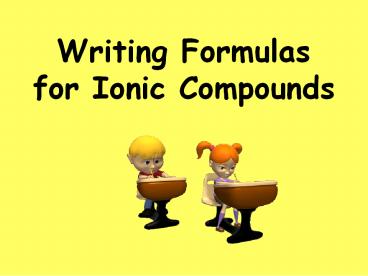Writing Formulas for Ionic Compounds - PowerPoint PPT Presentation
1 / 21
Title:
Writing Formulas for Ionic Compounds
Description:
Writing Formulas for Ionic Compounds Oxidation Numbers for the Group A Elements When you write ions, use the element symbol and the oxidation number written as a ... – PowerPoint PPT presentation
Number of Views:350
Avg rating:3.0/5.0
Title: Writing Formulas for Ionic Compounds
1
Writing Formulas for Ionic Compounds
2
- Oxidation Numbers for
- the Group A Elements
3
1
2
3-
2-
1-
0
NA
3
- When you write ions, use the element symbol and
the oxidation number written as a superscript. - bromine
- sulfur
- cesium
called bromide in a compound
Br-1
called sulfide in a compound
S-2
Anions change end of name to ide.
Cs1
4
- If you need the oxidation number for a transition
or inner transition metal, it will be given to
you because these elements typically have more
than one oxidation number. - Ox. for transition/inner transition metals will
be in the form of a Roman Numeral! - Exceptions
- Pb and Sn use Roman numerals even
though they are NOT transition metals - Ag and Zn do NOT use Roman
Numerals even though they ARE transition
metals
5
- example
- nickel (II) chloride (NiCl2)
The (II) belongs to nickel
which means nickel has a 2 charge while chlorine
has a -1 charge!
6
What is the oxidation number for the metal in
each compound?
Pb4
- Lead (IV) oxide
- Scandium (II) nitride
Sc2
7
Monatomic Ions
- A monatomic ion is an ion made up of one element.
- examples H1 O-2 F-1 Ba2
- Monatomic ions bond to make a binary compound.
- Binary compounds are made of a monatomic cation
and a monatomic anion.
8
To Write Formulas with Monatomic Ions, use the
criss-cross method!
bromine name changed to bromide in a compound
- Write the formula for barium bromide.
- First Write each element symbol and oxidation
number. - Always write the positive ion first!!!
- Next Criss-cross the oxidation numbers. Swap
the ox. s and write them as SUBSCRIPTS (lose
the and signs)
Ba2 Br-1
Ba2 Br-1
Ba1Br
1
BaBr2
2
9
Write the formulas for
- Iron (III) chloride
- Sodium oxide
- Magnesium nitride
10
Polyatomic Ions
- A polyatomic ion is an ion made up of more than
one element. - These are on the back of your periodic table!
- The entire polyatomic ion has an oxidation number
(NOT the individual elements).
11
Polyatomic Ions
- Example PO4-3 is the polyatomic ion phosphate
with an oxidation number of -3. - Example SO3-2 is the polyatomic ion sulfite
with an oxidation number of -2. - Most polyatomic ions end in the suffix ate or
ite.
12
To write formulas with polyatomic ions
- First Write each element and polyatomic ion
symbol and oxidation number. - Always write the positive ion first!!!
- Next Place polyatomic ion in PARANTHESES
- Finally criss cross the oxidation numbers
- NEVER, NEVER, NEVER, EVER CHANGE THE SUBSCRIPT
WITHIN THE POLYATOMIC ION ITSELF!
13
- Write formulas for
- Calcium Phosphate
- Magnesium Nitrate
14
- ONE LAST NOTE Chemical formulas must be in the
lowest, reduced form!!! - Write formulas for
- lead (II) oxide
- calcium sulfide
15
Lets Try More!
16
Nomenclature of Ionic Compounds
- Nomenclature means naming.
- Naming Ionic Compounds with Monatomic Ions
- First Name the cation (positive ion) DO NOT
CHANGE THE CATIONS NAME IN ANY WAY and write it
down. - Note If the cation is a transition or inner
transition metal, you must indicate its charge
(the oxidation number) using Roman numerals in
parentheses after the metals name. - Ex iron (II) chloride its chemical formula is
FeCl2
17
- Ex What would these anions be named in a
compound? - Oxygen ______________
- Sulfur ______________
- Nitrogen ______________
- Iodine ______________
- Phosphorus ______________
- Chlorine ______________
18
Name These
- Ex NaCl ____________________
- Pb3P2 ___________________
19
Naming Ionic Compounds with Polyatomic Ions
- First Name the cation ion first (NEVER CHANGE
THE CATIONS NAME). - Note If the cation is a transition or inner
transition metal, you must indicate its charge
using Roman Numerals in parentheses after the
metals name. Ex iron (II) hydroxide (its
chemical formula is Fe(OH)2) - Next Name the polyatomic ion ON THE BACK OF
THE PT (NEVER CHANGE THE POLYATOMICS NAME). - HINT Polyatomic ions usually end in ate or
ite!
20
Try These
- Li2SO4
- (NH4)2O
21
- I will do the rest with you on the board!































